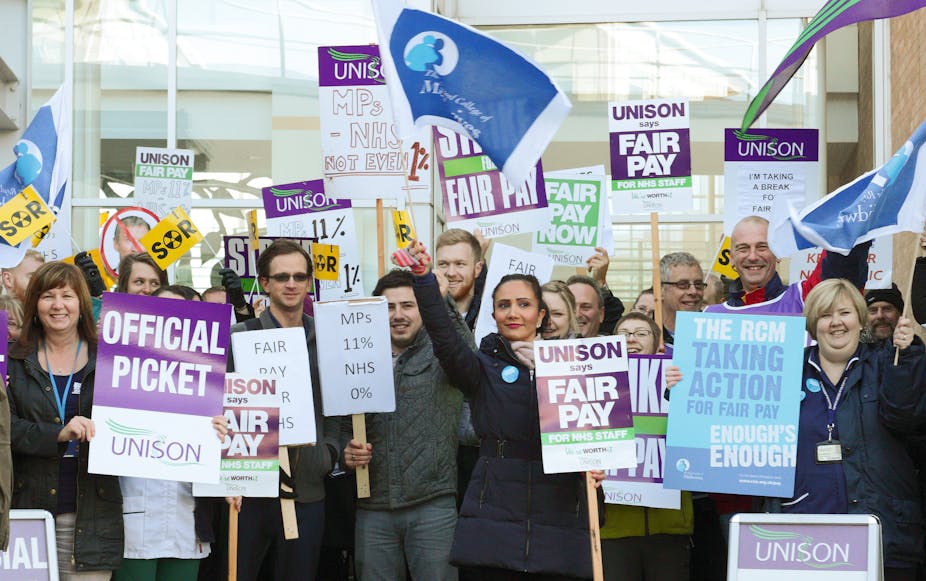Jeremy Corbyn’s landslide victory in the Labour leadership contest has inevitably provoked claims that Britain’s unions could soon rediscover some of the power they once wielded. Already there has been talk of strikes, demonstrations, civil unrest, crippling the country and toppling the government.
Irrespective of whether it comes from the unions themselves or the media outlets that routinely demonise them, this is muscular stuff. But the muscles in question have long since begun to atrophy, even if Corbyn’s rise gave the TUC a welcome spotlight for its annual congress this week. It is likely to take more than a political earthquake if those muscles are to be flexed anew.
Shipping membership
Numbers alone tell the tale. The UK has witnessed a dramatic reduction in unionisation since the 1970s. By the eve of the 21st century just 28% of workers were affiliated – down from 53% in 1979 – and there has been no sign of a significant revival since.

Various ills have been blamed. Competition, growing managerial influence and macroeconomic concerns such as wage and unemployment levels have all played a part. But the principal driver, by common consent, has been a failure to organise workers in newer establishments.
Quite why unions have struggled in this last regard has remained largely undetermined. Given that the fall in membership has coincided with a rise in women’s share of the labour market, one explanation might well be a shift in the male-female balance within the workplace.
Woman’s hour
The long-held and widespread perception of gender discrimination generally and within the union decision-making structure in particular could be another factor. Unionisation relies on coalition-building, which is hardly likely to be encouraged by persistent fears – justified or not – of institutionalised sexism.
So does it follow that chauvinism has been pivotal in lessening unions’ appeal and, as a consequence, eroding their power? Such a possibility had never been seriously investigated in this country until the question was addressed several years ago in a Nottingham University Business School study.
The research drew on the British Workplace Employment Relations Survey, which contains information representative of every UK business with five or more workers. Two key variables, workplace gender diversity and workplace union density, allowed us to measure the relationship between the male-female composition of a business and employees’ union participation.

As a result, chauvinism’s contribution to unionisation’s decline could be qualified for the first time. The results clearly showed how union involvement decreases as more females join a company. In short, workplace demographics have radically altered since the 1970s; union demographics, by comparison, have changed very little – and union hierarchy even less so.
I appeared on Woman’s Hour to discuss the study shortly after its publication in 2012. I was joined by a representative of the TUC – a woman, naturally – who took me to task in no uncertain terms. I remember finding the encounter decidedly bruising.
Looking again
Even so, I stood by our findings. And I still stand by them. We recently revisited the issue, drawing on the most up-to-date data available, and the fact of the matter is that the pattern persists. The work is still under review, but contact me to find out more.
Why? Historically, of course, unions have been male-dominated. As the data show, many women are still unwilling to join what they perceive – rightly or wrongly – to be organisations that practise discrimination.
At the same time, some male members are so chauvinistic in their resistance to change that they would sooner step down than accommodate increased female involvement. They regard severing all ties as preferable to countenancing a less “traditional” approach. The evidence gathered implies that they would rather abandon ship than sail in an unfamiliar direction.
Together, these two enduring trends – female reluctance and male intransigence – make for a perfect storm. They go some way to explaining why union membership has been steadily dwindling over the course of the past 30 years and more.
Lost art
The constructive strategies many unions have implemented since the 1990s have been acknowledged in a number of studies, not to mention highlighted by my fellow combatant during my Woman’s Hour ordeal. Needless to say, these initiatives should be applauded. Yet the bottom line is that the figures, as ever, speak for themselves.
Unionisation has always been underpinned by the notion of a shared identity. It is right to concede diversity inevitably makes this noble ideal harder to realise, but the objective is by no means impossible to achieve.
Rediscovering the lost art of solidarity may well be one of the key challenges unions have to confront if they genuinely hope to regain the clout they once enjoyed. It is less a political issue and more an organisational one, and it boils down to embracing the 21st century rather than merely aspiring to survive it.

